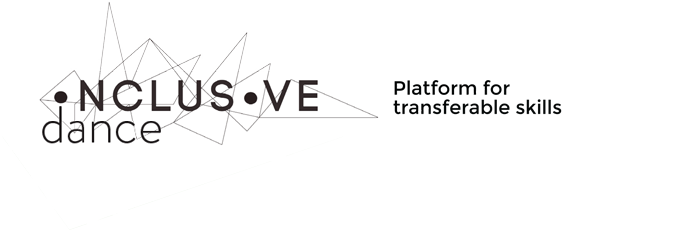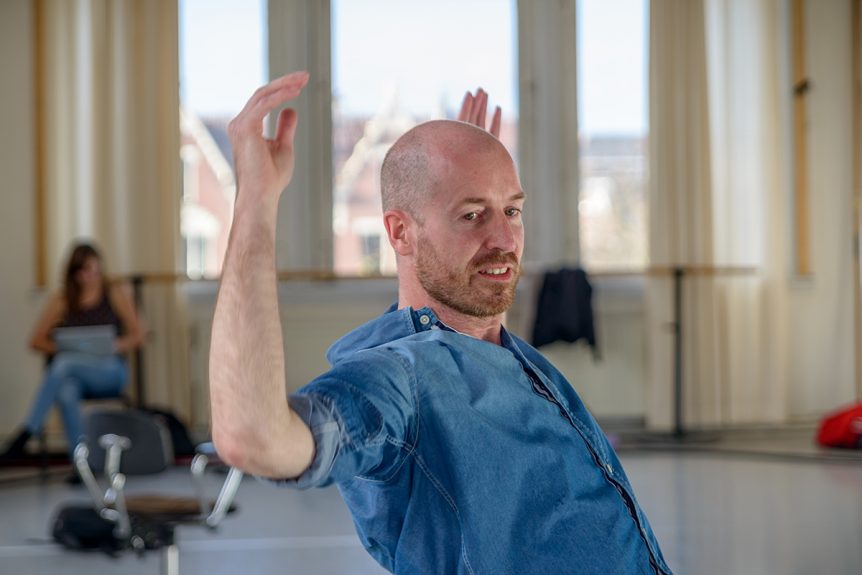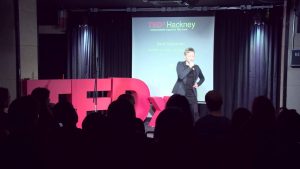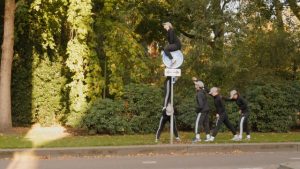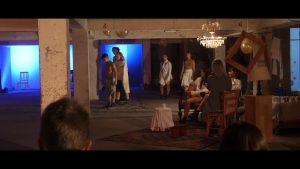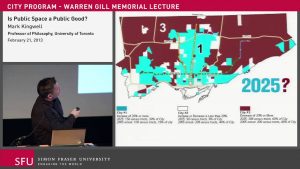The Dutch dance curator Marc Vlemmix and the British choreographer and ballet master Andrew Greenwood met when they developed together the artistic program of the dance house Station Zuid in Tilburg from 2004 till 2012. When Marc got diagnosed with Parkinson, they created in 2012, Dance for Health, a foundation to improve through movement the quality of life of people, Parkinson patients in particular. They developed their own method, which is based on the model which was developed by the Mark Morris Dance Group and the Brooklyn Parkinson Group in New York.
Andrew, do you remember your original fascination for dance? What motivated you to go and study dance?
Andrew: The motivation didn’t come from me. It came from my desperate parents trying to find an outlet for my energy. They tried judo, hockey, rugby, football. But I had the fortune or rather misfortune to have red, curly hair and during the rugby and the judo, I stuck out and was a bit picked upon. So my grandmother suggested to send me to the dance studio and suddenly I was chased around for very different reasons. It was just me and about thirteen little girls, all seven years old. Suddenly I was allowed to run around and it felt safe. I had a sense of being treated special. That was the beginning.
Can you describe from that original moment at seven, the different stages of your dance education?
Andrew: As a kid, it was just fun but more and more there was another plan being developed that I was not aware of myself: ‘he has the physical facilities for it’. Before I knew, I was auditioning and I had the luck to go through the wonderful education of the Royal Ballet. I say wonderful because of the privilege to work with such amazing teachers. At the same time, the older you got, the harder the struggle and the competition got. But these struggles are probably the source of my survival today. It wasn’t easy but one thing you do learn: discipline and the principle that ‘the show must always go on’.
Marc, your original education was very different from Andrew’s. At what point did you get attracted to dance?
Marc: My path is totally different form Andrew. My first contact with dance came very late in my life. I was born in a small village without a theatre or a dance company. Later I studied design and communication in Rotterdam, nothing to do with dance. While living in Rotterdam, friends took me to the theatre and one of my first experiences was seeing Scapino Ballet and from then on I became a passionate spectator.
At university we also had the possibility to do a three month training in the field. I chose the Rotterdam Dance Academy and I joined their ballet, jazz and modern classes. I was very curious to find out how it felt from the inside as well so I ended up crawling on the floor in a Kristina de Chatel like piece.
What were the kind of skills that you developed in your original training that are still valuable today?
Andrew: It sounds a bit far fetched, but I had an amazing empathy for animals to the point where other kids would bring me a bird they had found. I became the animal advisor. I had a lot of love and interest in nature and animals. I started to be caring for other things and people through animals and that stayed with me.
My vocation was really with the ballet. Next to the basic survival skills, it was mainly learning to work with your body, with the pain. Learning to constantly push your body to its limits, obviously gives you an in depth understanding of it.
Can you talk a bit more about the awareness of your body which you developed?
Andrew: There is a natural awareness and a natural body intelligence but in the training you come more and more attuned to things that are possibly out of balance or need more work. Through the education you become aware of your limitations. At the same time you have to constantly address this and try to push forward. There is this inner conflict with yourself.
Ballet is one of the profession that is very easily gradable. You know that the person in front of you is more flexible or that you have more jump. You learn to deal with the machine you are given. You find ways to accept it and you constantly try to retune and redefine it. So you become more and more aware of what is going on internally.
You mentioned the survival skills, the ballet world being very competitive. Were there other social skills you had to develop as well?
Andrew: Absolutely. The group dynamics were very important. You are most of the time ‘naked’. You are literally stripped off of external things. You are there in your tights. Everybody knows you and it becomes a very tight, knit group. You constantly have to compete but there is also a lot of solidarity. You learn very quickly that you are both an individual who has to strive for his own aspirations and that you are also part of a collective and that you do need to also have community awareness. I definitely learnt to work in a group.
How did you both move from your education into the professional dance world?
Marc: I started my professional career in the city theatre of Arnhem as programmer. A city theatre has to cater for everybody so the program ranged from cabaret and musical to theatre and pop concerts. Dance was a very small part of this but the part that interested me the most.
Meeting with other programmers, you had to formulate what you saw and felt so I started to develop a language to talk about dance and to communicate also with the artists, which I would meet at the international festivals I visited. I discovered that it wasn’t always easy to understand each other: talking about dance from the outside or inside, we were using different vocabularies.
Andrew: When you go through ballet education you are channeled to a specific direction. Today there is probably more diversity, but we were really trained to become ballet dancers. I realized quite early that being a ballet dancer was also a great opportunity to see the world. I wanted to travel and work with as many companies as possible. I took the risk and succeeding in doing that. After London, I was in Dusseldorf, the States, Brazil, Italy and Argentina. I enjoyed being in a completely different culture and environment.
This mobility and flexibility you describe is very much part of the dance world. But it is also becoming more and more the reality of other professional fields.
Andrew: Absolutely. For instance travelling to Brazil and being in Rio, the first thing you need to do, is to respect the environment and the dynamics of the local culture.
At thirty-four, I decided to become a choreographer, which was probably an ego thing. I decided to become even more nomadic and I gave up my apartment. I had to be inventive to find the necessary support. For instance, I put myself forward as the artistic director of the World Wide Fund for Nature. Giving myself this title, I wanted both to support my own mission of being creative and their mission.
At the same time, in order to survive, I also started to teach and I fell in love with teaching and made a living as a ballet master. I hadn’t forgotten what it was to be a dancer myself. I knew what I liked and didn’t like. With the recipes of my past, I started to develop my own ways.
Big part of your talent as a teacher are your communication skills. How did you develop these?
Andrew: I developed my communication skills out of my insecurities and out of this inner drive to explore the world. I found out very early: ‘always ask, always be communicative’. It grew into a calculated skill.
I have seen you teach professional dance classes and I also took part in one of your Dance for Health classes with Parkinson patients. What strikes me most is this amazing capacity of finding an appropriate language to reach out to people, through imagery, through metaphors.
Andrew: Using the opportunity of dance to travel the world, you learn to read people. I am always very observant of the crowd in front of me. The success doesn’t lie in being manipulative but in the integrity, honesty and conviction with which you are standing there. A group of people will always know when you are faking it. But if you really believe in what you are communicating, in my case the power of dance, they will believe it as well.
You both collaborated in Danshuis Station Zuid in Tilburg which Marc directed from 2004 till 2008, but then towards the end of that period, something important in Marc’s personal life happened which also influenced both your professional careers and which brought Marc back to the dance class.
Marc: Then my dancing career really started! In 2010, I was diagnosed with Parkinson, which was a big shock but in a strange way also a gift because I experienced for the first time a deep desire to reconnect with my body; to understand its limitations; to discover what it still could and couldn’t do anymore. I didn’t want the illness to take over my life. I started to take dance classes with Andrew. It was no longer about learning steps, choreography or aesthetics. I had to find myself again, to reconnect with my body and to start moving again, not only physically but also mentally. Even in a social way, it made a big difference.
Out of that personal experience, you decided to create Dance for Health to share your own experiences with a larger group of people.
Marc: That is how I am trained. When I see something I personally like and benefit from, I want to share it with as many people as possible. Dance for Health is a foundation to share the knowledge and methods Andrew and I developed; to train other teachers to pass it on.
You very consequently define Dance for Health not as dance therapy but as ‘creative wellness’.
Marc: The best way to explain it, is where it came from. The original diagnosis took only ten minutes and I got out of the doctor’s office with a flyer with all the symptoms I could get and the advice to get physiotherapy, treating those symptoms. Physiotherapy is perfectly fine and I sometimes need it myself, but it wasn’t sufficient for me. If I only had to do movements which were focusing on my problems, it would be a very negative starting point to move.
The difference with Dance for Health, which we call ‘creative wellness’, is that we never talk about the problems or symptoms. The end goal is to feel well, but we reach it by creativity and fun. Therapy is always something given to you from the outside while creative wellness is something you are responsible for yourself, which comes from the inside and which you incorporate yourself in your life.
Dance for Health has not only been reaching out to the professional dance world and to the medical and scientific world, you also consciously have been training dance educators in a particular way to apply their skills in a different context. Can you expand a bit on your training practice?
Andrew: The main aim of our training program, which is a difficult aim, is to make it as plural as possible. In the sense that are dancers/participants are in very different states and moods every time you meet them. Their conditions are each time different. With the Parkinson dancers, it is slightly easier, because you can be more specific with them, injury or health specific. But with the MS-dancers, it is constantly floating: one day they have a knee problem; the other day it is just fatigue. Their conditions are constantly shifting. So as a dance educator you have to be very flexible and sensitive to these shifts. To find one direction in the education is a challenge. So the first thing we did, was to make a base, which we call the four pillars and a catch stone.
The main pillar is the artistic and aesthetic: dance and its relationship to music.
The second pillar is the physical.
The third pillar are the social aspects.
The fourth pillar is the cognitive.
The catch stone is the heightened well-being of life.
So we give an extended training on those five pillars. We use Laban as a common language because its structure is very good and we have a certain vocabulary we can work with, such as for instance flow and energy. We are trying to make it more systematic and obviously you have the does and don’ts which come from our own experience and from the medical colleagues who accompany us. But at the same time there is a fine line between giving a base line and offering the necessary freedom to be able to react flexible to the ever shifting conditions of the participants.
What kind of people are you looking for, to be trained in this specific way?
Andrew: Until now, we have had a very diverse group with very different backgrounds. You do need a solid technical base in dance but this could be anything: ballet, modern, jazz. We are looking more and more for people that actually had a professional career as a dancer and have an extensive creative background rather than people who come from a dance therapy background. We look at the multidisciplinary side of dance, with all its facets: imagination, memory, stimulation, music, drifting off. The most positive result is when you get someone into a flow, which is difficult to reach. You need to create a particular state which arrives out of a mixture of creativity, phantasy, the relationship to music, memory. Because of that we prefer teachers who have had a creative career as well.
If you look at the prognoses for the future, some of the biggest epidemics in 2030 will be sedentary life, stress, Alzheimer. There is time and again medical proof that the key to avoid this is movement but the hardest thing to do is to motivate people to move. Dance is one of the best ways to stimulate that. So there is a lot of room for creative, professional people out there who want to apply their skills in these contexts, before shifting completely out of the dance world.
The journey of Dance for Health has been also a huge learning curve for both of you in which you learnt from each other and exchanged complimentary skills as a team.
Marc: Our journey individually and together is such a powerful example of the power of dance, arts and creativity in general. We can bring this to very different worlds, from the medical and scientific community to the corporate world and in doing so, we are both challenged to define and communicate in word and movement what we do, so that it is understandable for everybody, also for people who don’t have a background in dance or aren’t even interested in it.
Andrew’s starting point is the movement. Mine is originally more from the head: the policy making, the management. We are now at a point where we know enough of both sides to create a complete story in both word and movement and we learnt from each other in a way that we can also tell this story separately: that I can teach a movement class and Andrew can address the policy makers.
Andrew: We live in a time where the traditional roles in society are shifting and blending. You see this for instance very clearly in an institution as the National Ballet. In the past, it would never have been possible or even imaginable that amateurs would be performing on their stage. Our own experience is also a good example of this. Marc can now give a class in front of me and I can hold a meeting in front of Marc. We are bouncing off on each other and we are giving each other the confidence to do so.
Last question, what are your visions for the future for Dance for Health.
Marc: Short term: to develop more the real collaborations between the different worlds: the artistic, the medical, the corporate. We are at a point where we are becoming now in our field an innovative authority which brings us in the position to be a valuable partner for other institutions in other fields.
Long term: to develop a way of thinking and a change in roles where something like Dance for Health is no longer needed because it is integrated in everything we do.
Andrew: Very similar to Marc. Dance should never lose its identity as both a past time, as a creative endeavor and as a high class performance practice but it can also be used and should be used as a possible answer to a lot of other things such as illness, depression or stress. It is also a science and it is also a medicine and we can support this with research and evidence based results. But we don’t need to fully dissect it.
Rotterdam, 2016
Photocredits: Marc Vlemmix by photogrpaher Rob Hogeslag
